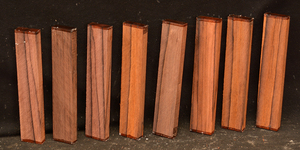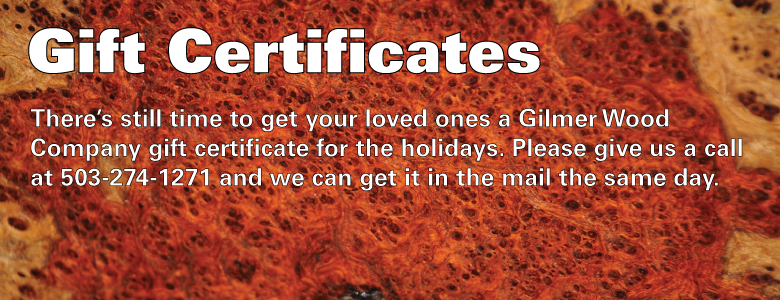-

The heartwood of African Blackwood is purplish to brownish-black with dark gray streaks giving an overall impression of being black. Lustrous with an attractive inner chatoyance. Very hard, heavy, close-grained, and virtually free from pores. Its main use is in turning, and it claims the title of the finest of turnery woods, well known as the standard by which other turnery woods are judged. Long a favorite of ornamental turners, the nature of the wood allows very fine detail with sharp cutters, leaving a beautiful, burnished surface.
Some blanks may have sapwood corners or more, burly or wild grain, occasional bug holes, small inclusions, small checks, i.e. they have the small defects common to Blackwood. That said these have to be the best quality rejects I have seen in nearly 30 years. A good percentage have no discernible defects and those that do have minor ones.
They are an odd size to make it easier to turn the bell or flared end of a clarinet. On one end they are 2 3/4-3 1/4" square and the other end is 1 3/8-1 5/8" square with tapered sides as in the photo. Length is 4 3/4-5 1/4".
The barrel will ship via freight truck. Please call us if you have any questions. 503-274-1271
Due to CITES regulations, we can only ship this species to customers in the United States.
A has 195 pieces.
B has 189 pieces.
C has 206 pieces.
D has 198 pieces.
E has 208 pieces.
F has 198 pieces.
-

220 volt, three phase, no tooling. Would prefer pick-up from our warehouse in Portland, Oregon but might be persuaded to crate and ship.
Give us a call for more details. 503-274-1271
-

Also called European Basswood, this species grows throughout Europe. It was the favorite wood of the English carver Grinling Gibbons and the German Gothic sculptor Tilman Riemenschneider. Pale in color, it has a straight grain and fine, even texture. It is easy to work and can easily be carved with, against, and cross the grain. It is recognized as one of the classic carving woods. Air-dried.
-

One of several rosewood species from Madagascar. It has beautiful color and grain, a sweet smell, and is very easy to work and stable in use. It is a very close match to true Rio or Brazilian Rosewood (Dalbergia nigra) and as such is much in demand for musical instruments, especially guitars.
Due to this item being on the CITES list, we are only shipping this species to addresses in the United States.
-

One of several rosewood species from Madagascar. It has beautiful color and grain, a sweet smell, and is very easy to work and stable in use. It is a very close match to true Rio or Brazilian Rosewood (Dalbergia nigra) and as such is much in demand for musical instruments, especially guitars.
Due to this item being on the CITES list, we are only shipping this species to addresses in the United States.
-

One of several rosewood species from Madagascar. It has beautiful color and grain, a sweet smell, and is very easy to work and stable in use. It is a very close match to true Rio or Brazilian Rosewood (Dalbergia nigra) and as such is much in demand for musical instruments, especially guitars.
Due to this item being on the CITES list, we are only shipping this species to addresses in the United States.
-

This striped wood develops a beautiful golden patina as it ages.
-

Beautifully variegated and colored, Black Limba is easy to work and finish. This wood is found in the equatorial forests of West Africa. Black Limba has wonderful tonal properties and is suitable for both solid-body guitars and acoustic guitars. Easy to work and takes a nice polish.
-

Beautifully variegated and colored, Black Limba is easy to work and finish. This wood is found in the equatorial forests of West Africa. Black Limba has wonderful tonal properties and is suitable for both solid-body guitars and acoustic guitars. Easy to work and takes a nice polish.
-

Also called Acajou, Tropical American Mahogany, and Honduras Mahogany. This medium to large tree occurs throughout Central and South America. Related to Cuban Mahogany (Swietenia mahogani) and Pacific Coast Mahogany (Swietenia humilis). It produces one of the classic furniture and cabinetmaking woods. The heartwood varies from a light reddish-brown to a rich, dark red. Generally straight grained and exceptionally stable, it is easy to machine, hand plane, sand and finish. Occasional logs produce several figures, curly, quilted, and the rare plum pudding figure which looks like large drips running down the board. Used in fine furniture and joinery, boat building, and in the guitar industry for acoustic sets and necks.
Due to CITES regulations, we can only ship this species to customers in the United States.
-

Also called New Guinea Rosewood. It is a beautiful, highly lustrous golden yellow color sometimes with reddish streaks. A nice turning wood it is also used in furniture, jewelry boxes, handles, etc. It is easy to work and glue and takes a nice polish.
-

The Sapele tree is found in tropical West & Central Africa. Even when without figure as this board Sapele has an amazing luster and takes a beautiful polish.
-

This striped wood develops a beautiful golden patina as it ages.
-

Almost all Pearwood imported into the U.S.A. has been steamed to bring out a more pinkish-red color and to prevent drying stresses. Formerly the wood was used for carving, turning, drawing instruments, wood engravings, textile printing blocks, and tool handles. Stained black it is an excellent substitute for Ebony. Contemporary uses include woodwinds such as recorders, furniture, kitchen accessories, jewelry and other boxes, and architectural uses such as paneling and doors.
A has wane on one edge.
-

The Sapele tree is found in tropical West & Central Africa. Even when without figure as this board Sapele has an amazing luster and takes a beautiful polish.
-

Also called New Guinea Rosewood. It is a beautiful, highly lustrous golden yellow color sometimes with reddish streaks. A nice turning wood it is also used in furniture, jewelry boxes, handles, etc. It is easy to work and glue and takes a nice polish.
These have some areas of cluster burls.
-

Sometimes called Gabon or Gaboon, this Ebony is sometimes jet black but oftentimes has grayish streaks that mostly disappear when finished or after the made object has been put into service. This Ebony has a marked resistance to checking that is characteristic of some of the Indian and Asian species. It has a wonderful texture and is easily carved, planed, turned, and milled. It is fairly fine-grained and takes a high polish. This Ebony usually originates in either Cameroon or Nigeria and the logs are rough hewn in the forest and oftentimes brought to the nearest road by human porters. With the disappearance of other species of black Ebony this species is fast becoming the Ebony of choice.
-

Sometimes called Gabon or Gaboon, this Ebony is sometimes jet black but oftentimes has grayish streaks that mostly disappear when finished or after the made object has been put into service. This Ebony has a marked resistance to checking that is characteristic of some of the Indian and Asian species. It has a wonderful texture and is easily carved, planed, turned, and milled. It is fairly fine-grained and takes a high polish. This Ebony usually originates in either Cameroon or Nigeria and the logs are rough hewn in the forest and oftentimes brought to the nearest road by human porters. With the disappearance of other species of black Ebony this species is fast becoming the Ebony of choice.
-

The heartwood is purplish to brownish-black with dark gray streaks giving an overall impression of being black. Lustrous with an attractive inner chatoyance. Very hard, heavy, close-grained, and virtually free from pores. Its stability and lovely tonal qualities make it an excellent instrument wood.
Due to CITES regulations, we can only ship this species to customers in the United States.
Click on the photos to see high resolution close-ups of the figure in each square.
-

The heartwood is purplish to brownish-black with dark gray streaks giving an overall impression of being black. Lustrous with an attractive inner chatoyance. Very hard, heavy, close-grained, and virtually free from pores. Its stability and lovely tonal qualities make it an excellent instrument wood.
Due to CITES regulations, we can only ship this species to customers in the United States.
Click on the photos to see high resolution close-ups of the figure in each square.




























